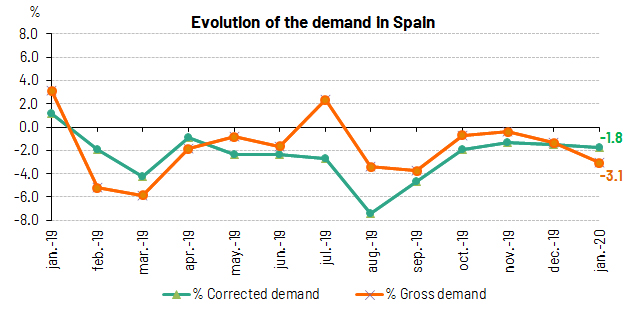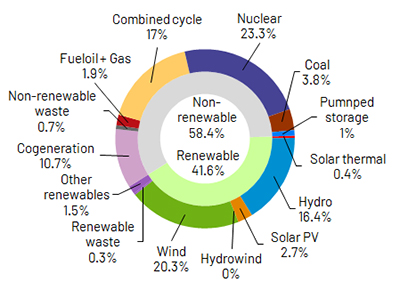We are a global operator of essential infrastructure
- 41.6% of the monthly generation came from renewable sources and 65.9% of the electricity generated was obtained using technologies which produce zero CO2 emissions.
- Demand for electricity decreased in the Balearic Islands and remained unchanged in the Canary Islands.
- January 2020 was the first month, since records began in Red Eléctrica, in which the Balearic Islands generated its electricity without using coal.

The demand for electrical energy nationwide in the month of January is estimated at 23,810 GWh, a value that is 3.1% lower than that registered in the same month last year. After having factored in the influence of seasonal and working patterns, the demand for electricity fell 1.8% compared to January 2019.

In January, and according to current estimated data, generation coming from renewable energy sources represented 41.6% of the total production.
65.9% of electricity generation during the month was obtained using technologies which produce zero CO2 emissions.
With information available as at the time of this press release, wind energy generation in January reached 4,622 GWh, a value 23.3% lower than in the same period last year, and accounted for 20.3% of the total production in Spain.
Generation mix in the month of January 2020

Demand for electrical energy in the peninsular electricity system falls by 3.2%
Demand for electrical energy in the peninsular electricity system in the month of January is estimated at 22,562 GWh, 3.2% lower than that recorded in the same month last year. After having factored in the influence of seasonal and working patterns, the demand for electricity fell by 1.9% compared to January 2019.
During January and according to current estimated data, 43.3% of the peninsular generation came from renewable energy sources and 68.9% was obtained using technologies which produce zero CO2 emissions. Furthermore, wind energy in January stood at 4,563 GWh, a figure that is 23.6% below that registered in January last year, and contributed 21.1% to the generation mix.
Demand for electricity decreased in the Balearic Islands and remained unchanged in the Canary Islands.
In the Balearic Islands, the demand for electricity in January is estimated at 456,461 MWh, a value that is 4.5% lower than that recorded in the same month last year. After having factored in the influence of seasonal and working patterns, the figure decreased by 1.2% with respect to January 2019.
It should be noted that this month is the first, since records began in Red Eléctrica, that coal has not been used to produce a single MWh in the Balearic Islands electricity system. In January 2019, coal-fired technology produced 217,725 MWh and represented a share of 64.1% in the total monthly generation.
Combined cycle, with 76.5% of the total, was the leading source of electricity generation in the Balearic Islands, whereas renewable technologies, which produce cero CO2 emissions, accounted for 4.9%.
Regarding the Canary Islands, demand for electricity is estimated at 755,694 MWh and this figure remains unchanged compared to that registered in January 2019. After having factored in the influence of seasonal and working patterns, the figure increases by 1% with respect to January 2019.
During January and according to current estimated data, combined cycle was the leading technology in the Canary Islands generation mix, with a contribution of 44.6%. Renewables and those technologies that produce zero CO2 emissions accounted for 10.4% of the generation on the Canary Islands.
Consult our Daily Balance Report for more information on the National, Peninsular, Balearic Islands and Canary Islands electricity systems as at the close of January.














